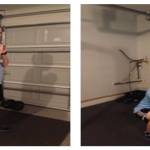Last week I talked about how the deadlift was one of the best exercises you should be doing. In this post, I want to talk about how to apply this lift to your daily activities. Since you are doing deadlifts now right? 🙂
So often, I see people pick things up off the floor like this.
We tend to gravitate towards the easiest way to perform a task. If we need to bend over, we round our back because this requires the least amount of energy.
Although it may be easy, it is dangerous. Take a look at this picture. The numbers you see at the bottom are the amount of force the back is subjected to during the movement.

Photo Credit: http://t2.gstatic.com/images?q=tbn:ANd9GcQXwpNcor2-4WBUsYTcWnBQZspMb1nc9BuiBRhdsIEVStg_iTqX
As you can see, when the spine rounds it is subjected to extreme amounts of force. And the person continually doing this may eventually end up in pain or injury. As the force increases, the structures of the spine (discs, vertebrae, ligaments, etc.) take a beating.
However, you can see in the picture on the right how the force is lowered when the back is flat and hips are hinged properly. This allows the hips to take most of the force, keeping the back safe.
The point of this post is to show you that not only should the deadlift be performed in the gym but out of the gym as well. When you pick an object off the ground (and I’m not talking about a barbell or dumbbell here), you should do it just like you perform a deadlift.
When you pick that box up to put in the trunk of your car, pick your child up when they fall down, or pick that pen up that you just dropped, it should look just like the deadlift. This is what I tell my clients all the time because I want to keep them as safe as possible.
If you want further proof on how the deadlift will help keep your low back healthy here is a great study.
This research project compared the muscle activity of the multifidis and erector spinea (muscles of the middle and low back areas) while performing several exercises. These included: back extensions, a bodyweight single-leg deadlift, a bodyweight single leg deadlift on a BOSU ball, a glute bridge on a BOSU ball, a deadlift performed at 70% of 1 rep max, and a lunge performed at 70% of 1 rep max.
The researchers found that the deadlift outperformed every exercise. It elicited higher average muscle activity (88%) and higher mean peak activity (113%) than all other exercises. What this means is that it does a great job of strengthening the muscles of your low back.
Now, I don’t want you to be afraid that your spine will explode if it rounds. Pain and injury that comes from this usually happens overtime time from continually doing it. Just try to remind yourself when you have to pick something up, that it should be done just like a deadlift (hips back and straight spine).
As you do this more and more it will feel natural. You will notice that you no longer get pain from bending over. And the less pain you have, the more you can do.
I tell you all this, because I have injured my back before. Once, I was handing a weight to a client and I rounded my back to give it to them. I immediately felt something pop.
I could barely walk for the next week. It was awful and it put me out of commission from the gym. From then on, I started looking at the deadlift as a movement pattern instead of just an exercise.
So please don’t treat the deadlift as just an exercise performed in a gym. Treat it as an everyday movement. I promise you will save yourself a lot of pain in doing so.
If you are looking for a personal trainer in Savannah, contact me to set up a consultation.
And if you found any of this information helpful, or know of someone it could help please share with others!
References:
1. Colado, J. et al. The progression of paraspinal muscle recruitment intensity in localized and global strength training exercise is not based on instability alone. Arch Phys Med Rehab. 2011. 92: 1875-1883.









1 Comment
[…] I wrote an entire article that explains this in more detail. You can check it out here. […]